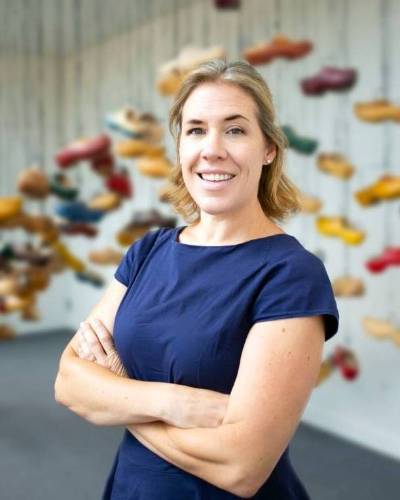Danielle Stewart finds home through art history
Danielle Stewart, a small town girl who discovered her love of art history through travel, education, independence and motherhood, is a curator and head of academic initiatives at the Nora Eccles Harrison Museum of Art.
Stewart has curated the recent women-centered exhibits the museum has been showcasing since January, prioritizing the inclusion of underrepresented art media through her position.
Stewart said she holds a strong love for the cultural influences of art today, but she wasn’t aware of her appreciation for it as a young girl growing up in the small town suburb of Antioch, California.
“Living there, it was very stable, but it was a little bit boring,” Stewart said. “It made me want to see what was beyond Antioch.”
The neighboring city of San Francisco gave Stewart a taste of broadened culture, movement and opportunity. It influenced her educational aspirations and inspired her to see more of the world.
“A really well-rounded education has two components,” Stewart said. “One is learning deeply about the place that you’re from, and the other one is learning broadly about the breadth of experience.”
Stewart wanted to attend college, though she wasn’t sure what to pursue. She decided to attend Brigham Young University, where she discovered an interest in art history.
“I’m a very visual person, so it felt to me like it made history make sense, and social relationships and the way people interact,” Stewart said. “That really felt like a way of explaining the universe.”
Throughout her college years, Stewart traveled to 20 countries in Europe as a part of a study abroad program. She visited many of the major European art museums and witnessed some of the most historically significant works of Western art.
Stewart then visited Brazil and Syria, continuing to broaden her knowledge of different cultures of art.
“It also opened up doors for me to think about what was available outside of Europe, and outside of the textbook, canon art history,” Stewart said.
After graduating, Stewart wrote her thesis statement on the cultural significance of Alice Brill’s Sao Paulo photography. Her thesis adviser and former professor, James Swensen, quickly became aware of Stewart’s passion for her artistic education.
“She just cruised to the top of her class,” Swensen said. “She was a glutton for punishment because I think even after she took it, she sat in on it a second time.”
Though Stewart had found her passion for art, she was unsure about what she wanted to do with her career.
“The expectation that I was given was that I would be home with children,” Stewart said.
Stewart had no husband or kids at the time and soon realized she was going to need to take care of herself.
Stewart decided to attend graduate school at the City University of New York. She continued to study art history and taught art all across the state as a part of her university fellowship program.
“When I finally got to live in New York, that was like the culmination of a dream for me,” Stewart said. “I realized I wanted to have a professional life. I just had never really been able to entertain that before.”
When she completed her Ph.D., Stewart continued her professional life and went to live in the United Kingdom where she worked as an assistant professor of Latin American art history at the University of Warwick for three years.
Stewart said she loved the time she spent traveling, but she began feeling a sense of homesickness.
“I felt like I had been imbibing that breadth of human experience, but I didn’t have any sense of rootedness or any sense of heritage or place that I was from,” Stewart said.
Stewart’s family had moved to Idaho while she was in college, but that place never became home for her.
Eventually, Stewart found her current job as an art curator in Logan. Unbeknownst to her at the time, Stewart moved into a home that had been originally built by her great-grandfather.
“It really felt like it was balancing for me,” Stewart said. “Even though I had never lived in Logan before, it felt like I was coming home to a family home.”
Stewart found a sense of connection, not only to her new home, but to her new job as well. She understood the importance of curating and connecting with the community, and especially with underrepresented groups.
Katie Lee-Koven, the executive director and chief curator at NEHMA, said she witnessed the impact Stewart has on the museum.
“Our goal is to serve all of campus, and as much of campus as we can, and she’s a really key piece to that,” Lee-Koven said.
Stewart said she had the idea to curate women-centered exhibits for the museum. She recognized the importance of including women’s perspectives, especially because historically, their work has been greatly underrepresented.
Stewart said her true appreciation for feminist art didn’t become whole until she became a mother. She hoped she would have a son because she was scared of the cruelties a daughter would face.
“Personal experience led me on a path of thinking more about women artists and what seeing their work and hearing their stories might have meant to me, and what they could still mean to me,” Stewart said.

